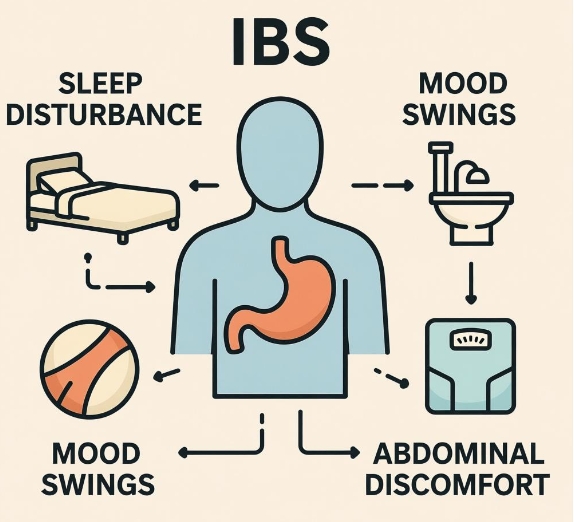Irritable bowel syndrome (IBS) is a functional gastrointestinal disorder characterized by recurrent abdominal pain linked to altered bowel habits, without detectable structural or biochemical abnormalities. Symptoms fluctuate over years, often beginning in adolescence or early adulthood, and can significantly impair quality of life while sparing life expectancy.
- Cardinal features
- Abdominal pain or discomfort: crampy, aching, or sharp, usually located in the lower abdomen; episodes last minutes to hours and are relieved by defecation.
- Change in bowel frequency: patients may experience >3 loose stools daily or <3 stools weekly; the pattern can alternate within the same individual.
- Change in stool form: using the Bristol scale, types 6–7 (mushy/watery) during diarrhea spells and types 1–2 (hard/lumpy) during constipation spells are typical.
- Sensation of incomplete evacuation: persistent urge after bowel movement, leading to repeated visits to the toilet.
- Visible abdominal distension: objectively measured increase in girth by evening, often accompanied by tight clothing.
- Subtypes based on predominant habit
- IBS-D: >25 % of bowel movements loose and <25 % hard.
- IBS-C: >25 % hard and <25 % loose.
- IBS-M (mixed): both loose and hard stools >25 % of the time.
- IBS-U: insufficient criteria for above categories.
- Associated non-colonic symptoms
- Upper GI: early satiety, nausea, epigastric burning overlapping with functional dyspepsia.
- Genitourinary: frequent urination, urgency, dyspareunia.
- Gynecologic: dysmenorrhea intensifying IBS pain mid-cycle.
- Fatigue, headache, and sleep disturbances: independent of stool pattern.
- Symptom triggers
- Food: fatty meals, caffeine, sorbitol, onions, garlic, beans, wheat, milk (via either lactose or FODMAP effect).
- Stress: examinations, job interviews, or personal conflicts can precipitate flares within hours.
- Hormonal: many women report worsening perimenstrually.
- Post-infectious: 10 % of acute gastroenteritis cases evolve into IBS through low-grade inflammation and altered microbiota.
- Red flags that exclude IBS
Age >50 at first onset, nocturnal pain awakening from sleep, bloody stools, unintentional weight loss, anemia, elevated inflammatory markers, or family history of colorectal cancer, celiac disease, or inflammatory bowel disease—these mandate further investigation. - Daily-life impact
Symptoms often peak during working hours; fear of incontinence leads to avoidance of long commutes or social events, creating a cycle of anxiety and heightened gut sensitivity.
Summary table
| Domain | Common presentation | Tip for patients |
|---|---|---|
| Pain | Lower-crampy, post-prandial | Heat pad, peppermint oil capsules |
| Stool | Alternating loose/hard, urgency | Keep 2-week diary to identify triggers |
| Bloating | Visible distension by evening | Reduce carbonated drinks, chew slowly |
| Non-gut | Tired, poor sleep, frequent urination | Regular exercise improves both gut and sleep |
| Alarm signs | Blood, night pain, weight loss | Seek immediate medical review |
